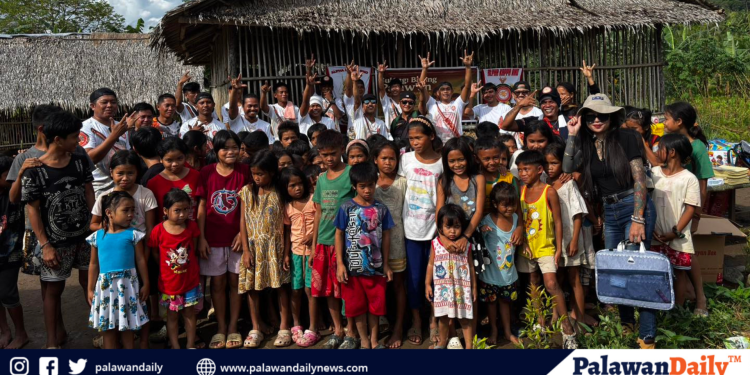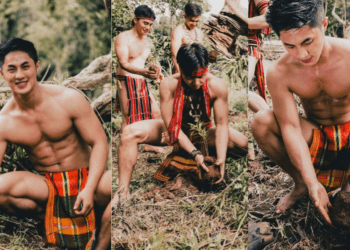On June 15, 2025, I turned 33.
No cake. No candles. No grand gestures. Just muddy trails, foggy ridges, and ninety-six indigenous children waiting for someone, anyone, to show up.
I started my day in church, something I hadn’t done in years. Not because I was trying to be holy, but because I needed silence before the noise. I needed stillness before the movement. I needed God, and not just the Sunday kind, but the kind who speaks when your heart is breaking in a place no one else can see.
And although I didn’t cry, something cracked open inside me during that morning. A surrender. A softening. A readiness.
That afternoon, I found myself in Barangay Candawaga, in the heart of Rizal, southern Palawan, standing on slippery muddy soil, watching children’s faces light up as they received slippers, raincoats, notebooks, and food, gifts most of them had never owned in their entire lives.
It was my birthday. But in every possible way, it was their day.
Most people reading this will never set foot in Maruso Elementary School. You won’t see how steep the climb is or how far these kids walk just to reach it. You won’t know the sound of mud squishing under dozens of tiny feet before sunrise. Or the silence that fills the classroom when there’s no chalk, no paper, no food.
You won’t see the teachers, only four of them, stretching themselves thin across multiple grade levels, managing everything from lesson plans to cleaning the school grounds. You won’t feel the weight of teaching in a classroom built from sawali and pawid, with no walls to stop the wind and no electricity to power even a fan.
This is what learning looks like in one of the most overlooked corners of Palawan.
And yet, there’s joy.
Even in that scarcity, there’s laughter. Even in poverty, there’s play. The children sing. They help one another. They sit on broken plastic chairs and share crayons. They dream, even when the world refuses to notice them. But hey, that’s why I came. And that’s why I stayed.
People often think you need an organization or a fund or a blueprint to start helping. I had none of that.
For years, I was a field reporter, chasing stories, deadlines, and truth. I was the one behind the bylines, always on the ground, documenting the lives of others while carefully keeping mine in the margins. I covered everything: ribbon cuttings, protest marches, crime scenes, festivals, council meetings that dragged into wee hours sometimes. I told the stories that needed telling, or so I believed. And when I became an editor, I traded the noise of the field for the silence of a newsroom, collecting other people’s work, guiding narratives, mentoring. It was a different kind of service, but still rooted in the same goal: truth.
But somewhere along the way, I began to feel the distance. I was still telling stories. But I was no longer in them.
Then, earlier this year, I came across a single photo on social media, a picture of an empty classroom in the mountains of southern Palawan.
No students. No teachers. Just a skeletal structure of worn out sawali walls and pawid roofing, standing unevenly on a dirt floor. The blackboard was faded and chipped, the chairs mismatched and worn. No books. No colors. No sign of comfort or ease. Just silence. Just absence.
But somehow, that one image spoke louder than any press conference I had ever covered. It was as if God had whispered through that photograph, cutting through the noise of my daily life. I had seen poverty before. I had reported on hardship, disaster, inequality. But this was different. This was personal. This time, I felt called.
It wasn’t a grand vision or a booming voice from the heavens. It was subtle, but unmistakable. I had a spiritual awakening in that moment. A conviction I couldn’t shake. A realization that I could no longer just write about what was broken. I had to help rebuild.
That photo, quiet and unassuming, became the catalyst. The beginning. The invitation to step away from the sidelines and say yes to something much bigger than myself.
From that moment on, I knew I had seen something I couldn’t unsee. It wasn’t just poverty in the material sense, though that alone was sobering. It was deeper than that. It was neglect: layered, generational, systemic, and suffocating. A kind of quiet abandonment that had calcified over years, decades, maybe longer. And it wasn’t just the fault of those living nearby or those in charge locally. It was on all of us, every person who had the privilege to look away, who saw the signs and moved on, who believed it wasn’t their responsibility simply because it wasn’t in their backyard.
This wasn’t just a remote community’s problem. It was a reflection of a national failure. A shared indifference.
And I knew then that I couldn’t write my way out of it. I’ve always believed in the power of words, but this time, no headline or byline could undo what I had witnessed. No feature story could patch a leaking roof. No essay could feed a hungry child or rebuild a rotting school.
I had two choices: go back to my desk and pretend I didn’t see it, or move. Show up. Do something—however small, however uncertain. Because there comes a point where bearing witness is no longer enough. You either become part of the healing, or you’re just another layer of silence.
And I chose not to be silent. So I left the newsroom. And I became a volunteer. Because sometimes journalism isn’t enough. Sometimes truth demands more than reporting, it demands action.
I started writing, not for publication alone, but for connection. I emailed NGOs. I messaged friends. I reached out to family. I posted. I prayed. And then, I waited.
To be honest, most messages went unanswered. Days passed with no replies. Nights filled with doubt. I started wondering if I was just another idealist trying to fix something too big. But slowly, something happened. People began saying yes.
After two weeks of being in Rizal, the first wave of donations had come in. And yesterday, thanks to so many generous hearts, we were able to deliver:
* 96 pairs of slippers and 96 raincoats, so the children could walk the muddy trail without getting soaked
* Notebooks, pencils, crayons, pad papers, and school supplies, bundled with love
* Teaching materials and children’s books from The Book Bridge Project, giving both teachers and students new tools to learn
* Four sacks of rice, plus thousands of pesos worth of noodles and sardines for the daily feeding program
* First aid essentials, including disinfectants, bandages, and vitamins
* Essential medicines from the Municipal Health Office (MHO) and Roots of Health
* 5 sheets of plywood and 140 pieces of pawid to repair leaking classrooms
* Transport and fuel vouchers from the Office of the Mayor of Rizal, who helped make delivery possible
* Boxes of pre-loved clothing and books sent by kind souls from Narra and Puerto Princesa
* Vegetable seedlings, which will eventually be used to build a mountainside hydroponic farm
* Volunteers from Alpha Kappa Rho (AKR) Rizal Chapter, who hiked, carried, cooked, and made the day possible
One of the most powerful moments that day wasn’t just when the kids smiled, but when their parents did as well. Parents who had walked miles just to say ‘thank you.’ Who had long accepted that their children’s education would come with hardship and hunger. For once, someone saw them. For once, help didn’t come wrapped in campaign slogans or photo ops. It came quietly. Lovingly. Personally.
Congressman Jose Chaves Alvarez, after hearing about the condition of the school, pledged to build two additional classrooms, a miracle we didn’t even ask for, but one that showed us: people are listening.
Let me be clear: this wasn’t an outreach. This wasn’t about making ourselves feel good.
This was an act of resistance, against apathy, against systems that ignore, against the slow death that comes from being forgotten.
We’re planting a hydroponic farm to ensure that feeding the kids doesn’t rely on handouts. We’re building toward a sustainable model, one that gives the school food, funds, and pride. We’re teaching the children that they don’t have to depend on outside help forever.
They will grow their own food. Sell their own harvest. And sustain their own classrooms. Because dignity isn’t given. It’s taught. And these children are more than recipients, they are partners in transformation.
Faith doesn’t wait for money in the bank. It doesn’t wait for a signed memo. It doesn’t ask for credentials. It moves, tired, unsure, but willing. And when faith moves, heaven moves. I’ve seen it. I’ve lived it. Every slipper, every notebook, every raincoat that arrived was proof that God answers not the loudest prayers, but the most surrendered ones.
It’s not always immediate. It’s not always easy. But it always comes when it matters. There were nights I had nothing to offer but exhaustion and silence. But every time I laid those down, I was filled. Not with ease, but with strength.
That’s what faith does. It carries you when the world says you’re crazy. It reminds you that even if you’re just one woman climbing a muddy mountain trail with a bag of slippers, you are enough when you are sent.
Maruso is just one school. There are dozens more, hidden in the jungles of Bataraza, scattered across the islands of Balabac, tucked into the ridges of Brooke’s Point, where children walk hours through rivers and slippery trails, with no food in their stomachs and no slippers on their feet.
I am not done. Because God is not done. And if He could take this one step of faith and turn it into a movement, imagine what He could do in those other forgotten places.
Imagine what He could do through you. So no, this isn’t a happy ending. It’s a sacred beginning.
Because sometimes the most powerful miracles don’t happen on mountain peaks. They happen on the way up, in the mud, in the sweat, in the silence of someone who chooses to show up anyway.


















